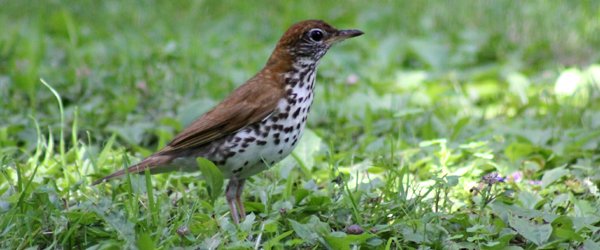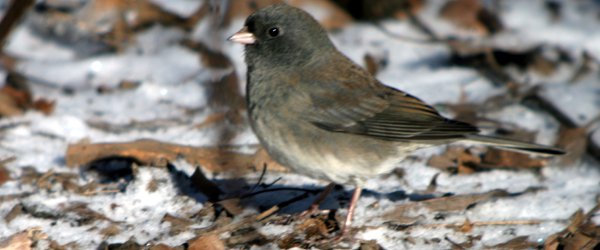
I’m not an ornithologist. I don’t even play one on TV. Nevertheless, I was pleased to find myself at ornithological ground zero this past week, as the American Ornithologists’ Union and the Cooper Ornithological Society held a joint annual meeting in Chicago. Months prior, a call for volunteers had gone out to local birders, and I happily signed up for a few shifts. (Especially happily that the meeting was held at the Palmer House Hilton, right near my office, so that I was able to spend my morning volunteering and still put in a full day at work.)
Handing out T-shirts at the registration desk with a summer intern from the Field Museum (one of the conference’s sponsoring groups) gave me a good feel for who was around and what ornithologists are like. They seem to be a friendly lot, with inquisitive minds and cheerful natures, and are always on the go. Some lingered to gaze at samples from the Field’s collection of bird specimens, such as perfectly preserved thrushes, warblers, and even a Rose-breasted Grosbeak under glass. Other hardy souls signed up for an early morning “Ostrich Run” 5k, with the prizes being–you guessed it–actual ostrich eggs. (Emptied of their contents, of course.)
A few days later, I was the assistant (a glorified gofer, if you will) for a morning-long session on migration. It comprised eight short talks on subjects ranging from investigations into the genetics of magnetic receptors for navigation, to the use of eBird and other “citizen science” crowdsourcing efforts in studying migrant phenology. I learned a lot about why young Wood Thrushes (like the one Corey photographed above) are less efficient at migration than adults (like human kids, they seem to make more pit stops along the way), and that Dark-eyed Juncos which spend all year in San Diego seem to have undergone a fairly recent genetic shift toward “sedentariness.” Fascinating stuff, with real conservation implications. Throughout the rest of the meeting, talks ranged from a plenary on bird evolution and the fossil record, to a collection of sessions focusing just on the Golden-winged Warbler. (Oh, if I didn’t have a day job!)
I study Juncos now. Juncos are cool. (Image by Corey)
Like most conferences, this one had an exhibit hall and poster session, too. Exhibitors ranged from book publishers to purveyors of telemetry equipment to local bird and wildlife groups. (Shout-out to Chicago Bird Collision Monitors!) The posters were pretty interesting too, covering topics such as territory use and aggression in Eastern Bluebirds and whether nonnative plants affect refueling stops among Gray Catbirds and Swainson’s Thrushes.
There was lots for attendees to do besides sit in hotel conference rooms, though. As you’d expect, experts led birding trips to local hotspots like the Magic Hedge, and there were ample opportunities to check out the Field’s avian offerings. I was sorry that prior plans meant I missed a screening of Ordinary Extraordinary Junco. Ornithologists got to see a plethora of “ironbirds,” too, as the annual Air and Water Show (think stunts and tricks by all types of airplanes and helicopters) was held all weekend just steps from the conference.
Perhaps the coolest part of the meeting was the abundance of young people, including an amazing teenage birder from my old suburban NY stomping grounds who is now studying at Cornell and who presented a poster. According to the program guide, nearly half of the presenters were students. Further, Midwestern ornithological groups sponsored local high school birders, who otherwise may not have been able to attend.
Although not all ornithologists are birders, and vice versa, there seemed to be a healthy amount of overlap and plenty for people of every skill level and interest to enjoy and learn about. So set your calendars for next year’s meeting, scheduled for September in Colorado. As a non-ornithologist, I was glad to get a behind-the-scenes glimpse of what these scientists do, and how they’re helping to promote the interests of the birds I know and love.












I’m sorry I missed the call for birders; the meetings sounded interesting and fun, even for gofers. Nice post, thank you for this recap. AND! Thank you for mentioning Magic Hedge in your profile, I had no clue. I must journey from the suburbs to this birding mecca.
@Dave: As long as one reader got it, that made it worthwhile. Allons-y!
@Arden: Sorry you missed it! And anytime you want a Magic Hedge guide, just ping me. 🙂
I’m so happy you wrote about the conference, Meredith. It sounds more tolerable than most academic get-togethers. And, the number of students is indeed a wonderful thing. Now–where is this Dr. Who reference? I can’t believe I missed it.
You probably would have really liked it, Donna — in addition to the sessions, there were lots and lots of books in the exhibit hall. And, since you asked, the photo caption is an 11th Doctor reference. (Man, have I waded far too deep into geek-dom.)